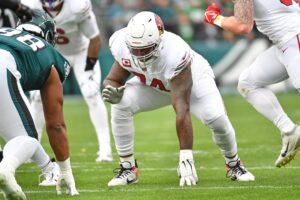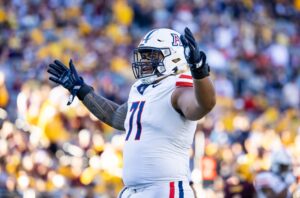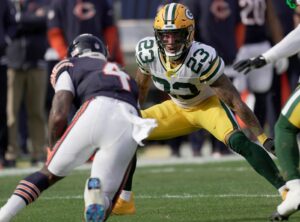If you have missed any ‘Implication of Success’ articles, catch up now! Quarterback, Offensive Line, Wide Receiver, Tight End, Special Teams, Run Defense, Pass Rush, Secondary
Six months ago, Alex Smith walked off the field of Arrowhead Stadium with his head down. Fans lingered in utter disbelief. Eric Fisher was the subject of a devastating holding penalty and Tamba Hali was left in disbelief regarding his lack of play. It was January 15th, 10PM in Kansas City, and the Chiefs had just suffered a devastating 18-16 loss to the Pittsburgh Steelers. Everything was prepped to go right, just as everything went wrong. To quote Charles Dickens, “It was the best of times, it was the worst of times.” Success was in the book for Chiefs Kingdom, and it slipped away just like that.
Six months later the stories have been prepped, the demands are known, and success is once again in grasp. Despite the tense brevity of the offseason (John Dorsey being let go, Jeremy Maclin’s release, the surprise drafting of Patrick Mahomes) hope has returned in the form of training camp. Over the past several weeks, I have painted the implications of success for the Chiefs. Yet, just as success proved so fragile on January 15th, the Kansas City Chiefs power ranking for 2017 is a room made entirely of glass.
Kansas City Chiefs Power Ranking – A Room of Glass
The Problem of a Mundane Offense
The painting of the Kansas City Chiefs is a team with an electric defense and a mundane offense. Alex Smith has most likely hit his ceiling, being no more than a game manager quarterback. Kareem Hunt and Spencer Ware are young running backs are young without a premier star to lead them. Finally, Andy Reid often opted to use the athletic Tyreek Hill in special sets and adhere to his short passing game.
Although the Chiefs are set to improve in 2017 by taking more risks and evolving to a pass set that targets more explosive receivers, the outlook is still dim. Limits, after all, are unfortunately limits.
To garnish tangible success the Chiefs truly need in 2017, the offense must forget that it even can be mundane. Hill’s production cannot be limited to him turning the short passing game into long gains. Instead, let him run down the sideline and use speed to embarrass slower linebackers and corners. Travis Kelce is a dominant pass-catching tight end that can turn even the most physical linebackers around. Thus, let him work in sets that open over the span of a game.
Let fear go.
Brave aggressiveness also needs to take over as the predominant mentality in play calling. Over the first half of last year, play calling was reserved in the second half. Long, churning drives in the West Coast offense are great when time is in favor of the offense. Yet, in the eyes of the Chiefs roster, they needed to score sooner instead of later. Their entire scheme revolved around returning to a pre-set playbook instead of letting play calling naturally evolve in game.
Part of the problem in the playbook again returns to Alex Smith’s limitations as a quarterback. Despite his fantastic leadership, he does not own the playbook. Deep playoff teams have quarterbacks that evolve from being presidential, to being a general that understands how to evolve not only leadership, but play calling over a game.
If a certain play style is not functioning, Smith needs to offer a harsh dose of reality to the Chiefs and audible to more poignant plays. Without that aggressive mentality, the Kansas City Chiefs power rankings will be marginally mundane. And if they let mundane slip back into their vocabulary for one moment, the glass room of success shatters.
Power of the Turnover
Creating turnovers has been a common theme among the implications of defensive success. Whether the front four, linebackers, or secondary, each unit has an intrinsic violence and passion to find the football. Yet, at the same time, without comprehensive focus across the entire squadron, the Kansas City Chiefs defense could soon become an empty suit.
Comprehensive success defined is that element of a defense which arises consistently across all opponents. In 2015, arguably the best of the Chiefs recent defensive years, a strategic understanding was beheld by each position group on how they supported one another. Big plays were rare, there was no bend, and opponents were stifled. Hence, a lack of chaos existed.
Fast forward to 2016, and the Kansas City Chiefs defense was good, but lacked a sense of comprehension. They still used the innate football violence to create turnovers and capitalize on mistakes, but those often came late in drives and at the hand of being in the right place at the right time (also known as football luck).
Creating turnovers is one thing; relying on lucky turnovers to sustain momentum is another.
Take away some of the lucky turnovers the Chiefs had bounce there way last year, and the defense is still good. This is not an attempt to dismiss how productive and efficient they were at stopping some of the best quarterbacks in the league (Andrew Luck, Drew Brees). Do not to factor in the plethora of injuries to key players (Hali, Justin Houston, Derrick Johnson) that made the defensive accomplishments even more impressive.
Yet, sustaining a dynasty on a “bend but don’t break” type of defense is a recipe for disaster. Again, the onus falls on new leaders rising and taking over their playbook so the All-Pros on the roster do not have to carry the entire burden.
Specifically, Dee Ford and Daniel Sorenson must evolve to consistent playmakers as part of a scheme. In summation, last year was a great year for the defense, but signs of unsustainability arose. And to avoid falling into a pattern of giving up fragile big plays, the Chiefs need to have players become intrinsic to the game plan opposed to creating random turnovers at random moments of grandeur.
Patterns of Frustration
Team chemistry and drive is just as important to deep playoff success as on the field of play. To say all is well among the Chiefs management and players would be dismissing an off-season filled with less than ideal drama. Although players have kept their voices inside (for the most part), there is an aspect of frustration that may bleed over detrimentally during the season.
Anecdotal, but letting players vent may be a better plan of action (a la Pete Carroll of the Seattle Seahawks). Andy Reid’s refined locker room balance works with a team that lacks overt characters. Hence, a lot of the players fall into step with Alex Smith’s quiet poise. The two most outspoken players would be Marcus Peters – who likes to ‘trash talk’ opponents and offer his opinion – and Chris Conley – who is a massive Star Wars fan and vocal in the film production field. Other than that, the most the Chief players are heard from are comments intrinsic to getting better at football or charity work.
Case and point: Tyreek Hill’s domestic violence case. After drafting Hill 165th overall in the 2016 NFL Draft, the media scrutiny began instantaneously. Reid and John Dorsey had selected a player who brutally beat up a woman. How were fans were expected to be happy? Yet, Reid and the Chiefs public relations treated the situation as respectfully and quietly as possible. Besides acknowledging the high character expectations and virtues to be demanded from Hill, a lot of commentary was kept inside the program.
This goes to a deeper and more old-school thought pattern of coaching that dates to Vince Lombardi. Coaching football for Andy Reid is not only about the football business, but about the character development he can attribute to players.
Lombardi was a tough coach for the Green Bay Packers. He would yell, swear, and work players harder than any other coach. But at the end of the day, the championship Packer teams were a family. More than anything Lombardi loved his players as if they were sons. In an era where football is so business, Reid is a coach that takes this same mentality to the offense.
Understanding the motivations of Reid begins to show the split between Dorsey that eventually lead to their parting. Reid’s love for the game and character building has built a very in-house, systematic program at Arrowhead Stadium. Reid loves his players, but he also recognizes the importance of a programmed football business – just as Vince Lombardi patterned his team with a definitive negotiating style.
Dorsey was leading a looser system that tended to be non-systematic; a sharp contrast to the buttoned-up Reid. The team was consistently against the salary cap, putting players under pressure and in strife with management. Dorsey was regarded as a softer negotiator, but at the end of the day, the results were inverse and players were being pushed out.
Go back to Dontari Poe and Jamaal Charles not returning as Chiefs. Both players were revered as cornerstone players by Reid. However, due to high contracts elsewhere, the team had to move on. Yes, Poe may have had weight and production problems in 2016, and Charles was aging and banged up, but they were highly respected players with room to grow.
The buckle was strained further during the NFL Draft. Although purely rumors at this point, there may have been disagreement over the drafting of Mahomes. Regardless of the effect on the front office, it put Smith at the dichotomy of having a young first-round quarterback behind him. Fortunately, Smith is an exceedingly mature leader, and has welcomed Mahomes with no qualms.
Where did the straw break between Dorsey and Reid? The release of Jeremy Maclin. Although Maclin’s performance in 2016 was subpar, and injuries had dampened his season, the Chiefs had no choice but to move on due to inconsistent negotiating from Dorsey in other salary cap sections. Maclin was the oldest receiver in the room, a favorite of Andy Reid, and regarded as a leader. After being with Andy Reid since his days as a Philadelphia Eagle, losing Maclin was losing a son for Reid.
Strangely, all was quiet for many of the Chiefs. Under Andy Reid’s quiet tutelage as a coach, players had little room to vent. That frustration, however, poured over in a recent Twitter rant from Hali. With Twitter as a medium now for players to vent their thoughts, Hali is among the first Chiefs to do so.
And with that, the shaky state of the Chiefs system is more or less confirmed to be a glass house. Hali’s venting is intrinsically healthy before camp – a way for fans to be prepared for commentary to come. In the end, he doesn’t want a new contract or Reid to be gone. Instead, he wants to play more, and he wants to make that clear. Hali is simply using Twitter, not journalists, to make his stance perfectly clear (more on Hali later this week because this does open an interesting dialogue that only the Seattle Seahawks and Richard Sherman have had the honor to walk through).
This is a glass house where success will be so important to cherish. The bar is high to take the AFC West again, and that glass house perception is more important than ever. Do they have what it takes? Maybe. Words are one thing, play is another.
And that is the beauty of football – you have to play the game. Welcome to the 2017 season Chiefs Kingdom.






